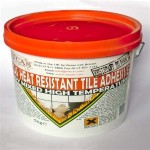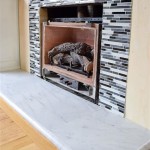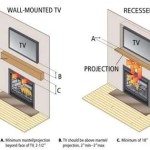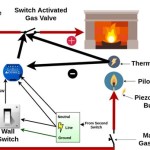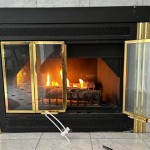DIY Outdoor Fireplace Frame: A Comprehensive Guide
An outdoor fireplace can transform a backyard into a cozy and inviting space for relaxation and entertainment. Building the fireplace frame yourself, rather than purchasing a pre-made structure, offers considerable cost savings and allows for customized design features. This article outlines the process of building a durable and aesthetically pleasing outdoor fireplace frame, focusing on essential considerations, materials, and step-by-step construction techniques.
Planning and Design Considerations for Your Fireplace Frame
Before commencing the construction phase, meticulous planning is crucial. This includes determining the location, size, style, and functionality of the fireplace. Careful consideration of these aspects will ensure the finished product meets your specific needs and complies with local building codes.
The initial step involves selecting an appropriate location for the fireplace. Factors to consider include proximity to the house, prevailing wind direction, and potential fire hazards. Avoid placing the fireplace under overhanging trees or near flammable materials. Ensure sufficient clearance from structures and property lines, adhering to local regulations regarding fire safety.
The size of the fireplace frame should be proportional to the scale of the surrounding outdoor space. A large fireplace in a small yard can overwhelm the area, while a small fireplace in a large yard may appear insignificant. Determine the desired dimensions based on the intended use. Consider the size of the firebox, the mantel, and any surrounding seating areas.
The aesthetic style of the fireplace frame should complement the existing architecture and landscape design. Common styles include traditional, rustic, modern, and contemporary. Consider using natural materials such as stone, brick, or wood to create a cohesive and visually appealing design. Research different styles and gather inspiration from online resources or home improvement magazines.
Consider the functionality of the fireplace. Will it be used primarily for warmth, cooking, or ambiance? If cooking is a priority, incorporate features like a grill or cooking grate. If ambiance is the main objective, focus on creating a visually appealing design with a prominent firebox. Ensure adequate ventilation to prevent smoke buildup and promote efficient burning.
Before beginning any construction, it's paramount to research and comply with all applicable local building codes and regulations. These regulations may stipulate specific requirements for fireplace construction, including setbacks from property lines, chimney height, and fire safety standards. Contact your local building department to obtain the necessary permits and inspections. Failure to comply with these regulations could result in fines or require the removal of the fireplace.
Material Selection for a Robust Fireplace Frame
The choice of materials significantly impacts the durability, safety, and aesthetic appeal of the fireplace frame. Selecting appropriate materials is essential for ensuring the structural integrity of the fireplace and its ability to withstand the elements. Common materials used in outdoor fireplace frame construction include concrete blocks, bricks, natural stone, and lumber.
Concrete blocks (CMUs) are a popular choice for fireplace frame construction due to their affordability, durability, and ease of installation. They provide a solid foundation for the fireplace and can be easily stacked and mortared together. Concrete blocks are also fire-resistant, making them a safe choice for the firebox area. However, they may require a decorative veneer to enhance their aesthetic appeal.
Bricks offer a classic and timeless look for outdoor fireplaces. They are available in a variety of colors, textures, and sizes, allowing for a wide range of design possibilities. Bricks are also durable and fire-resistant, making them suitable for both the frame and the firebox. Brick fireplaces often require more skilled masonry work than concrete block fireplaces.
Natural stone provides a rustic and natural aesthetic that blends seamlessly with outdoor environments. Stone fireplaces can be constructed using various types of stone, including fieldstone, limestone, and sandstone. Natural stone is durable and weather-resistant, but it can be more expensive and difficult to work with than concrete blocks or bricks. The weight of the stone requires a substantial foundation.
Lumber, specifically pressure-treated lumber, can be used to construct the framework for the fireplace. This is often used in conjunction with veneer materials like stone or brick. The lumber frame provides a structure to attach the veneer to, and it can be a more cost-effective way to achieve the desired look. It is crucial to ensure the lumber is properly treated to resist rot and insect damage. Any lumber closer than code allows to the firebox requires fire-resistant materials surrounding it for safety.
When selecting materials, consider the climate in your area. In regions with harsh winters, choose materials that are resistant to freezing and thawing cycles. In coastal areas, select materials that can withstand salt water and high humidity. Proper sealing and waterproofing are essential for protecting the fireplace frame from the elements.
The mortar used to bind the materials together is also a critical component. Select a high-quality mortar specifically designed for outdoor use. Follow the manufacturer's instructions carefully to ensure proper mixing and application. Proper mortar joints are essential for the structural integrity and weather resistance of the fireplace.
Construction Sequence for a Home-Built Fireplace Frame
The construction of an outdoor fireplace frame involves a series of steps, starting with site preparation and foundation construction and culminating in the installation of the firebox and chimney. Careful execution of each step is essential for ensuring a safe, structurally sound, and aesthetically pleasing finished product.
Begin by preparing the site. Clear the area of any vegetation, debris, or obstructions. Excavate the ground to the required depth for the foundation, ensuring the soil is properly compacted. The depth of the foundation will depend on the size and weight of the fireplace. A reinforced concrete slab is typically recommended as the foundation for larger fireplaces. Check your local codes about the depth of the slab foundation.
Construct the foundation according to the specifications outlined in your plans. If using a concrete slab, pour the concrete and allow it to cure completely before proceeding with the frame construction. Make sure the foundation is level and square. Accurate measurements are essential for ensuring the stability and alignment of the fireplace frame. If using a gravel base, make certain it's also level and at the appropriate depth.
Lay the first course of blocks, bricks, or stone, ensuring they are level and aligned. Use mortar to bind the materials together, creating strong and consistent joints. Stagger the joints in each successive course to increase the structural integrity of the frame. Use corner blocks or interlocking pieces to create a strong and stable structure.
Continue laying the blocks, bricks, or stone, building the frame to the desired height and shape. Periodically check the level and plumb of the walls to ensure they are straight and true. Use a level and a plumb bob or spirit level to make necessary adjustments. Cut the materials as needed to create the desired shape and size.
Construct the firebox using fire-resistant materials such as fire bricks or a pre-fabricated metal firebox insert. Ensure the firebox is properly insulated to protect the surrounding frame from excessive heat. Firebricks require specific high-temperature mortar for installation. Follow the manufacturer's instructions for installing the firebox or insert.
Install the chimney flue, ensuring it is properly sized and positioned to provide adequate ventilation. The chimney should extend above the roofline to prevent smoke from blowing back into the yard. Follow local building codes regarding the height and placement of the chimney. A chimney cap can prevent rain and debris from entering the flue.
Apply a decorative veneer to the frame using materials such as stone, brick, or stucco. This will enhance the aesthetic appeal of the fireplace and protect the underlying structure from the elements. Carefully select the veneer materials to complement the overall style of the outdoor space. Ensure the veneer is properly attached to the frame using mortar or adhesive.
Construct the mantel using wood, stone, or concrete. The mantel provides a decorative element and can also serve as a shelf for displaying items. Ensure the mantel is securely attached to the frame. The depth of the mantel should be proportional to the size of the fireplace.
Allow the mortar and adhesive to cure completely before using the fireplace. Follow the manufacturer's instructions for curing times. Once the fireplace is dry, conduct a small test fire to ensure proper ventilation and functionality. Monitor the fireplace closely during the initial burn to identify any potential problems.
Adding final touches like landscaping around the fireplace can enhance its appeal. Create a seating area with comfortable chairs or benches. Lighting can also add to the ambiance of the space, making it a cozy and inviting place to relax and enjoy the warmth of the fire.

How To Build An Outdoor Stacked Stone Fireplace

Chris Loves Julia Diy Outdoor Fireplace Home Sweet Homes

How We Built Our Outdoor Fireplace Chris Loves Julia

Stonetutorials Living Stone Masonry
:max_bytes(150000):strip_icc()/chrisjulia-971f3f9eb708447bbd364fc7f4a16280.jpg?strip=all)
10 Free Outdoor Fireplace Construction Plans

Build An Outdoor Fireplace The Shed

How To Build An Outdoor Fireplace In 20 Minutes Diy

Building An Outdoor Fireplace Step By Guide Diy Home Improvement Blog

9 Outdoor Fireplace Design Ideas The Family Handyman

Denis Diy Outdoor Fireplace Patio Idea Genstone
Related Posts

